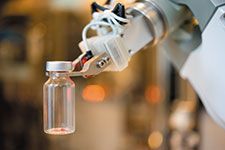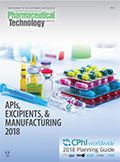Robotics Solve Aseptic Filling Challenges
Automated robotic arms manipulate nested trays and containers inside closed aseptic filling systems.
shutterstock.com/Bork

In aseptic and sterile drug fill/finish and inspection, automation can reduce or eliminate operator intervention, which reduces contamination potential and improves efficiency. Traditional, one-axis automation works well for high-speed processes, but multi-axis robotic arms offer repeatability with the flexibility to easily change the process or the type of container being filled. Technology advances have made robotic systems suited for aseptic processing and easy to operate.
While the pharma industry may be more familiar with robotics used in packaging operations, advances in technology, such as “near zero particle generating designs and complete tolerance to in-situ biodecontamination cycles with gaseous hydrogen peroxide” have made robotics compatible with aseptic manufacturing, explains Josh Russell, director of business development and technical sales at AST.
Today’s robotic systems are also easily reprogrammed for changes after the system is set up, without requiring a programming specialist on staff, say suppliers. Some platforms, such as those from AST and Vanrx Pharmasystems, are recipe-driven, and an operator inputs the recipe information-such as the type of container and volume to be dispensed-through a touchscreen interface.
Flexibility for small batches
Flexible and repeatable filling are becoming more crucial due to changes in the biopharma industry, notes Chris Procyshyn, CEO at Vanrx Pharmasystems. “The focus on targeted therapies for smaller patient populations creates a challenge for companies to produce a higher number of smaller batches into different container formats. Biologics, plus new modalities such as cell and gene therapies, are more complex and process intensive. The use of robotics is growing in response to these changes,” explains Procyshyn.
A potential drawback to robotic systems is running speed. “These systems aren’t yet designed to run 500,000 unit batches or produce 100 million units a year. But that’s not where the demand is anyway, and conventional systems weren’t meeting the need for small batch flexibility,” says Procyshyn. “If a company is making high-value drugs into multiple formats or sizes, they want a robust, repeatable process that reduces risk. That happens best with a closed robotic filling system.”
“Traditional aseptic systems are proving to not be well suited to address these personalized therapeutic products because they lack the ability to efficiently produce low-volume, high-mix batches,” agrees Russell. “However, robotic systems that have recipe-driven operation and the ability to process syringes, vials, and cartridges on a single platform are an ideal solution.” In addition, more companies are finding that robotic systems give them the flexibility, ease of use, and sterility assurance they need to replace manual filling of clinical batches.
“From a staffing standpoint, automating these tedious and repetitive processes reduces the risk associated with precise dosing and employee fatigue, and automation can reduce scrap and re-work [compared to manual methods],” adds Walter Langosch, Global Business Development director at ESS Technologies. For example, the company’s TaskMate robotic syringe filler/capper, which was introduced in December 2016, replaces manual methods and can fill and cap up to 15 syringes per minute.
“We clearly see a high demand for robotics in aseptic filling,” says Sebastien Schmitt, Robotics division manager, North America, at Stäubli. One growing use is in automated compounding pharmacies in hospitals, in which robots can be programmed flexibly to produce drugs on demand, adds Schmitt. Robotics provide consistent performance, with less equipment inside an isolator, hence, reducing risk and facilitating maintenance.
Steriline Robotics, a spin-off company created by Steriline with Milan Polytechnic, produces aseptic filling machines primarily used in hospitals and in pharmacy compounding. “The machine we developed uses two robots cooperating to help pharmacies in targeted drug reconstitution for each patient, according to their specific prescription,” notes Federico Fumagalli, chief commercial officer at Steriline.
Steriline is focused on “zero-loss” aseptic filling systems that aim to increase production efficiency and reduce the waste associated with rejects using traditional automation. Their robotic system can, for example, identify a filled vial that is missing a stopper and send it to be stoppered during a second cycle, preventing the loss of that vial, says Fumagalli. Steriline’s systems run faster than some other robotic systems due to their artificial-vision system, reaching a filling speed of almost 100 vials/min, he says.
Solution for nested vials
Nested vials have been available for more than five years, and the technology to optimally handle vials in this format is now catching up, says Russell. In AST’s ASEPTiCell and GENiSYS aseptic filling and closing machines, six-axis articulated robots perform all the critical aseptic operations, including removing the tub from its sterile overbag, opening the tub, and denesting the containers (i.e., vials, syringes, or cartridges). After filling, the robot closes the containers almost immediately, resulting in less time that the sterile drug product is exposed to the aseptic environment. “The system is completely closed. It eliminates operator intervention and allows a completely aseptic fill,” says Russell. Depending upon the application requirements, the system can be used inside a restricted access barrier system (RABS), isolator, or laminar airflow hood.
The robotic system allows a streamlined deck that is easier to clean than traditional automation, explains Russell. Another advantage over fixed automation is that the robot has various pre-programmed “maintenance positions” where it is ergonomically positioned for operators to access the disposable fluid path and to perform other necessary aseptic tasks without violating basic “first air” principles. In addition, the robotic system enables a real-time fill-weight check. AST’s machine uses an in-process feedback loop to the filling pump for closed-loop control. In addition to the commercial-scale ASEPTiCell i100 line, a laboratory-scale line GENiSYS was introduced in October 2017 for small-scale filling for R&D (e.g., stability studies), for clinical production, and also for small-scale commercial production, such as cell and gene therapy.
Gloveless isolator
A common use of robots in aseptic processing is to use a robot to replace certain operations, such as removing the cover from a nested container tub. Entirely rethinking the aseptic filling process, however, allows manufacturers to take full advantage of robotics. Procyshyn explains, “First, robots provide a highly repeatable production process. Using recipe-driven processes, they are able to produce multiple drug products at equally high quality levels into different containers. Second, robotic systems are agile and change quickly between vial, syringe, and cartridge formats. Robots can handle every type of container the same way if the containers and closures are nested, so there are limited change parts. Without traditional electro-mechanical components complicating the machine’s interior, decontamination cycles are much shorter too. Third, robots allow the design of gloveless isolators. A gloveless isolator can run much cleaner than a conventional isolator and be completely closed. [There are] no mouse holes, conveyors, glass-to-glass contact, or sortation bowls, which all create risks to the batch.”
Procyshyn notes that Vanrx Pharmasystems SA25 Aseptic Filling Workcell gloveless isolator technology is based on a standard design, which allows filling operations to be built faster than before (with lead times of less than a year) and in less space. The workcell design provides agility, with the ability for one machine to fill multiple container formats with minimal changeover times. “Gloveless isolator technology provides better aseptic assurance than conventional isolators or RABs,” adds Procyshyn. The workcells are entirely closed to the outside environment, and they also use single-use product-contact materials.
Contract development and manufacturing organization (CDMO) FUJIFILM Diosynth Biotechnologies announced in a May 23, 2018 press release that it was investing in the SA25 Aseptic Filling Workcell gloveless isolator technology as it expanded its gene therapy and viral vaccine fill/finish capabilities to provide services in support of late-phase candidates and commercial supply (1). Fujifilm highlighted the advantages of automated environmental monitoring and no glass-to-glass contact.
Vanrx Pharmasystems recently introduced a smaller-scale gloveless isolator system, theMicrocell vial filler, designed for rapid scale-out of personalized medicines, such as cell and gene therapies and immuno-oncology products, from clinical through commercial manufacturing. (2). The system replaces manual filling and small-volume filling machines in biosafety cabinets, RABS, or isolators, says the company. The Microcell can fill 2R-50R nested vials with toolless changeover and decontamination in 15 minutes.
Robotic inspection system
PTI–Packaging Technologies & Inspection’s new robotic inspection system uses the company’s MicroCurrent High Voltage Leak Detection (HVLDMC) to test the container closure integrity (CCI) of prefilled syringes. The E-Scan 665 tester is a fully automated system in which a six-axis robot picks and places rows of syringes from the nested trays into the HVLDMC and returns good product to the tray and faulty product to a reject tray. The inspection equipment company chose to use robotic actuations for the automated system because of the complex and delicate component handling required, says Oliver Stauffer, CEO of PTI. Robotic handling can have throughput limitations and may not work for higher speed processes, he notes, but it is suitable for this application, in which a tray of syringes is checked in less than three minutes. “Robotic systems provide flexibility in handling and adjusting for different format types and sizes. Technical requirements can often be achieved by simply adjusting positioning with the same end-of-arm tool,” says Stauffer.
Cobots
Stäubli’s TX Stericlean series was the first robot introduced in 2008 for aseptic production areas, says the company, which reports that its new TX2 line of collaborative robots (i.e., cobots) are also a first for aseptic processing. The use of cobots allows glove boxes to be located next to the robot, so that the operator can intervene in the isolator without stopping the production process. The TX2 robots are Industry 4.0-compatible, in that they can collect production data and are capable of communicating with each other, reports the company.
References
1. Fujifilm USA, “Fujifilm Announces the Expansion of Its Fill Finish Services to Include Late Phase and Commercial Production of Gene Therapies and Viral Vaccines to Become an End-to-End Solutions Provider,” Press Release, May 23, 2018. http://www.fujifilmusa.com/press/news/display_news?newsID=881420
2. Vanrx, “Vanrx Microcell Wins INTERPHEX ‘Best in Show’ Award,” Press Release, April 18, 2018. https://vanrx.com/vanrx-microcell-wins-interphex-best-show-award/
Article Details
Pharmaceutical Technology
Supplement: APIs, Excipients, & Manufacturing 2018
September 2018
Pages: s20–s21, s30
Citation
When referring to this article, please cite it as J. Markarian, " Robotics Solve Aseptic Filling Challenges," Pharmaceutical Technology APIs, Excipients, & Manufacturing 2018 (September 2018).

Drug Solutions Podcast: A Closer Look at mRNA in Oncology and Vaccines
April 30th 2024In this episode fo the Drug Solutions Podcast, etherna’s vice-president of Technology and Innovation, Stefaan De Koker, discusses the merits and challenges of using mRNA as the foundation for therapeutics in oncology as well as for vaccines.